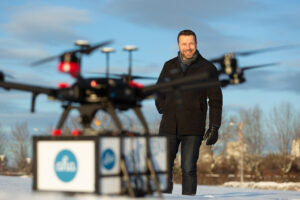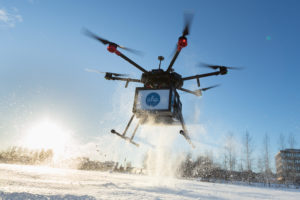
Maron Kristófersson is the CEO of Aha, a company that both provides a delivery service utilizing drones in Iceland; and helps companies to develop their own delivery services through a sophisticated software solution for delivery and logistics. Kristófersson is passionate about new and environmentally beneficial technologies – and Aha is proving that they can work, from electric vehicles to drones.
From Part 1 of this series: “Here we operate our own software on aha.is and run Iceland’s largest online marketplace: with instant deliveries of hot food, groceries and retail goods -all delivered in 30-90 minutes from traditional stores with either limited or no e-commerce capabilities. We do this in one of the hardest markets – Iceland is sparsely populated, has high costs, high salaries, and very low unemployment.
We do this using a fleet of 100% electric cars and have been working since 2014 in adding drones to that fleet as well – with the first license granted in 2017.”

Key change 1 – Central point of gravity in vehicles.
“Keeping the battery lower to the road makes Electric Vehicles (EV’s) extremely stable,” says Kristófersson. “This allows us to revisit single person (single seat width) cars.”
Currently, cars need a significant wheelbase so that they do not tip over when going around a corner: but a narrow car might allow the lanes for cars and trucks that run through cities to be dramatically reduced in width, allowing for many more cars in the same space.
Key change 2 – No combustion.
“Combustion has limited us to open air infrastructure,” says Kristófersson. “It takes up significant space in a car, while leaving the central point of gravity high.” Having no combustion could allow governments to better utilize underground transportation lanes.
Key change 3 – Autonomous driving.
“Computer systems are much better at utilizing roads than humans,” says Kristófersson. “Specific autonomous lanes during peak traffic hours could transfer 2-3 x more cars than other lanes… and small single seat autonomous car lanes could handle 4-6 x more single person or delivery cars than other lanes.”
Human drivers need to leave a “gap” or space to drive safely: but this gap is dramatically reduced if computers with sensors are driving the cars.
Key change 4 -Moving roads underground.
“The cost of boring tunnels is multiple times lower than before, and minimal combustion makes this problem simpler than before,” says Kristófersson. “These tunnels could be zero emission only – and city noise levels will completely change in 20-30 years.”
Drones and the Future of Cities
“We are at the tipping point for electric transport, which is a gateway to new technology and disruptions,” says Kristófersson. “The disruption is within the city planners 10-30 year timeframe – so we need to adapt now. Drones, which require the least infrastrucuture and may have the most economic impact, will be an important part of this change.”
“Drones will have to integrate with different technologies,” Kristófersson points out. “Politicians and public officials do not always pick the best technology first.”
CEO DroneLife.com, DroneRacingLife.com, and CMO of Jobfordrones.com. Principle at Spalding Barker Strategies. Has enjoyed working with and around the commercial drone industry for the last 10 years. Attendance and speaker at Industry Events such as Commercial UAV, InterGeo, Interdrone and others. Proud father of two. Enjoys karate, Sherlock Holmes, and interesting things. Subscribe to all things drone at DroneLife here. Email is Harry@dronelife.com. Make Sure that you WhiteList us in your email to make sure you get our Newsletter. Editor1@dronelife.com.